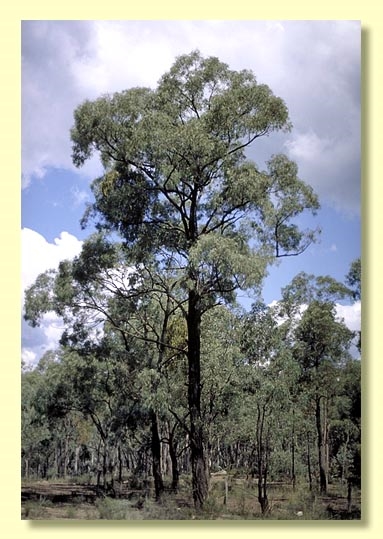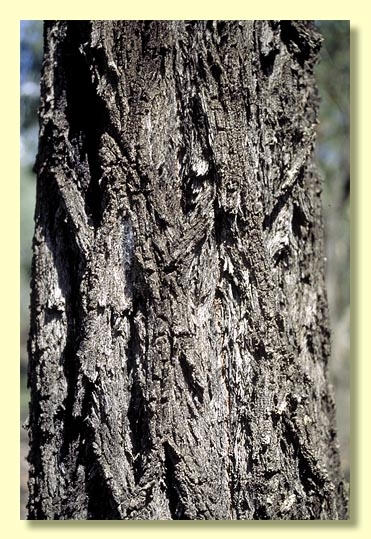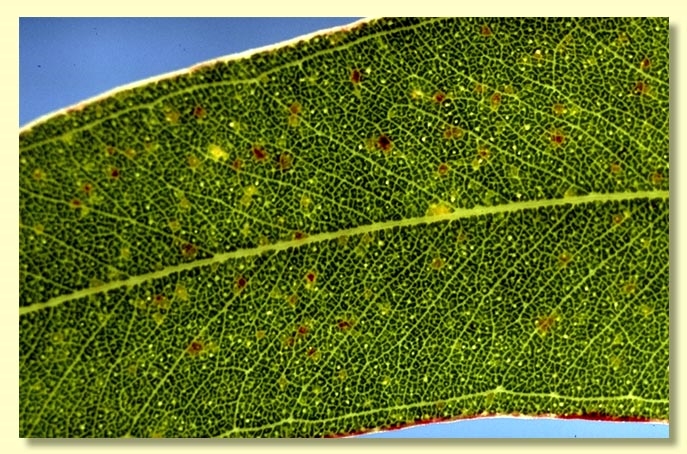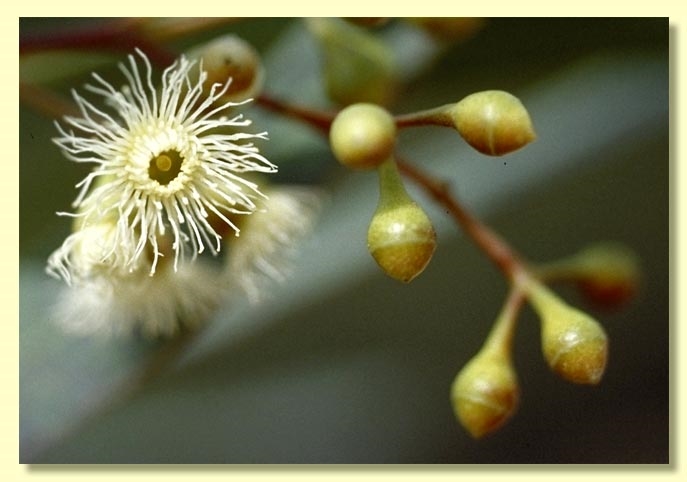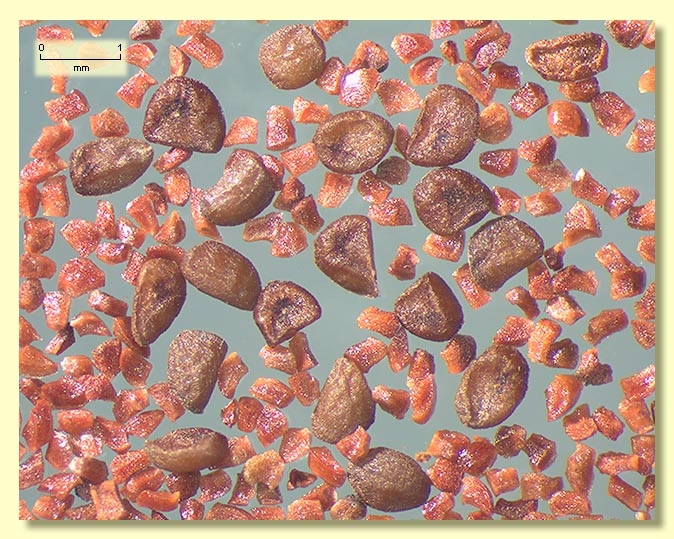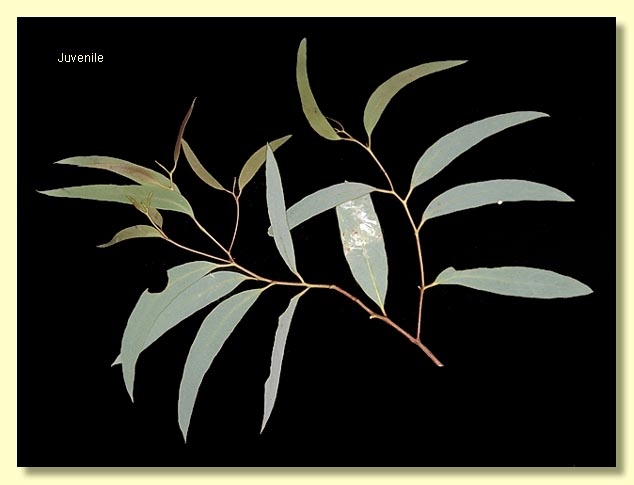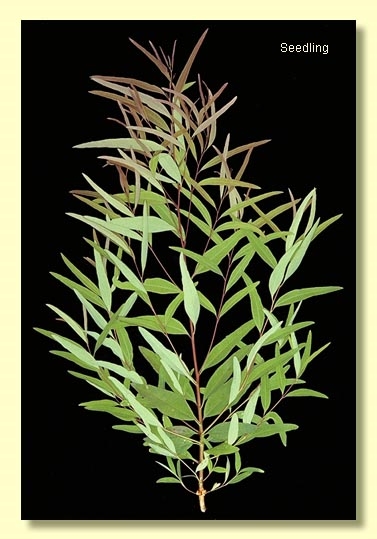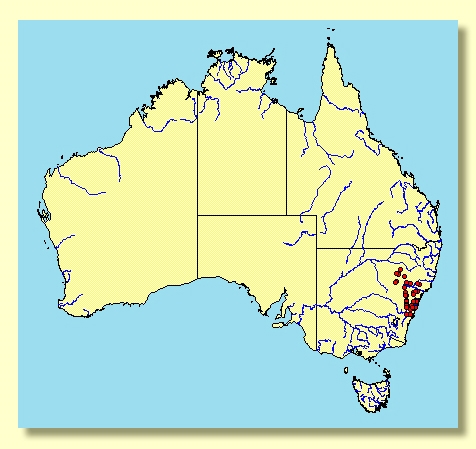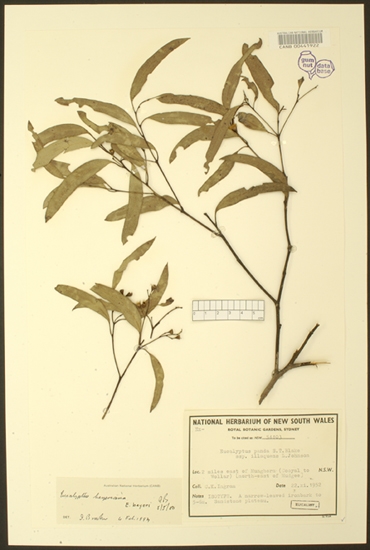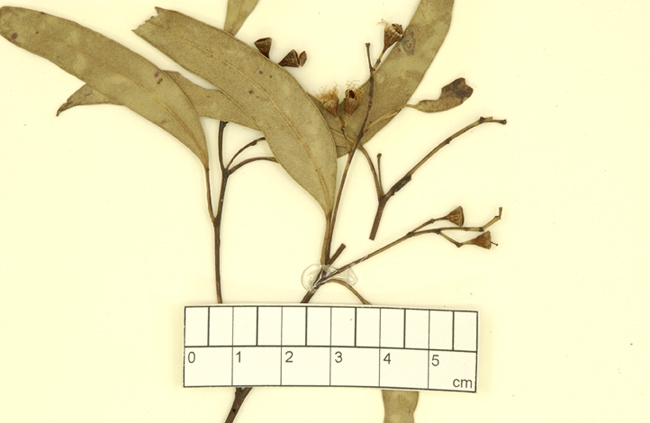Euclid - Online edition
Eucalyptus beyeriana
Eucalyptus | Symphyomyrtus | Adnataria | Terminales | Rhodoxylon | Concolores
T: NSW, Central Coast, Nortons Basin, about 2.5 km NW of Wallacia, T.James 889, W.Bishop & C.Dunn, 2 Sep. 1987; holo: NSW; iso: CANB.
(The name E. beyeriana L.A.S.Johnson & K.D.Hill was given for a new type specimen because the type specimen of E. beyeri was considered to have "anthers intermediate in morphology between those of E. beyeriana and E. crebra F. Muell. .[and].. Since the type is thus apparently from a plant of hybrid origin, the name E. beyeri R.T. Baker can no longer be applied in its widely-used sense, and a new name is required." (Johnson & K.D.Hill (1990)). One of the authors of EUCLID (the late M.I.H. Brooker) viewed Baker's type specimen and disputed this interpretation of stamen and anther morphology. However the name E. beyeriana is accepted by Australian Plant Census (2006) and that is now follwed in EUCLID.)
Ironbark throughout, dark grey to black. Forming a lignotuber.
Juvenile growth (coppice or field seedlings to 50 cm): stem rounded or square in cross-section; juvenile leaves opposite for a few pairs, petiolate, becoming alternate, lanceolate, 5.5–9 cm long, 1–1.5 cm wide, green.
Adult leaves alternate, petiole 0.8–2 cm long; blade narrowly lanceolate to lanceolate, 7–14 cm long, 0.7–2 cm wide, base tapering to petiole, concolorous, dull, green to grey-green, side-veins greater than 45° to midrib, densely to very densely reticulate, intramarginal vein parallel to and just within margin or well-removed from it, oil glands island or intersectional.
Inflorescence terminal compound, (rarely axillary compound in axils below this), peduncles 0.5–1 cm long, buds 7 per umbel, pedicels 0.2–0.7 cm long. Mature buds ovoid to obovoid to diamond-shaped, 0.4–0.5 cm long, 0.2–0.3 cm wide, usually green, scar present, operculum conical to rounded and narrower than hypanthium, stamens inflexed, with outer staminodes, anthers adnate, positioned obliquely at filament tip, cuboid, dehiscing by terminal pores, style long, stigma pin-head, locules 3 or 4, the placentae each with 4 vertical ovule rows. Flowers white.
Fruit on pedicels 0.3–0.7 cm long, cup-shaped, obconical or truncate-globose, 0.3–0.6 cm long, 0.3–0.6 cm wide, disc descending, valves 3 or 4, near rim level or enclosed.
Seeds brown, 0.8–1.5 mm long, flattened-ovoid, often pointed at one end, dorsal surface pitted, hilum ventral.
Cultivated seedlings (measured at ca node 10): cotyledons reniform to oblong; stems square in cross-section; leaves always petiolate, opposite for ca 5 nodes then alternate, narrowly lanceolate to linear, 3–8.5 cm long, 0.5–2.5 cm wide, base tapering, green.
Flowering has been recorded in January, April, May, August, September, October and November.
A small ironbark tree usually of low stature occurring from about Nowra on the south coast of New South Wales north and north-west to the Pilliga Scrub. It is characterised by its small, dull, grey-green leaves, ovoid or diamond-shaped buds, obconical to cup-shaped fruit and linear to narrow lanceolate juvenile leaves.
Eucalyptus beyeriana is closest to E. panda, E. virens and E. sicilifolia. All four species have relatively small buds and fruit and linear to narrow lanceolate juvenile leaves. E. virens and E. sicilifolia are easily separated by having glossy green adult leaves (dull green to grey-green in E. beyeri). E. panda differs only slightly by having slightly larger fruit (0.5–0.7 cm in E. panda and 0.4–0.6 cm in E. beyeriana).
Other closely related ironbarks are E. ancophila, E. caleyi, E. fusiformis, E. dura, E. tetrapleura, E. suffulgens, E. melanoleuca and E. corynodes. They all differ by havinglarger juvenile leaves and barrel-shaped to funnel-shaped fruit (E. beyeriana with linear to narrow lanceolate juveniles and obconical to cup-shaped fruit). E. ancophila, E. dura, E. suffulgens and E. melanoleuca can be further separated by having glossy green adult leaves. E. tetrapleura differs further by having four-sided fruit.
Within its area of occurrence there are other ironbarks which may be confused with E. beyeriana. They are E. crebra, E. fibrosa subsp. fibrosa, E. fibrosa subsp. nubila, E. melanophloia and E. siderophloia, all of which differ in having buds with stamens all fertile and irregularly flexed.
Eucalyptus sideroxylon differs by having buds that hold the outer operculum into maturity and both the inner and outer operculum shed together at anthesis (no operculum scar).

